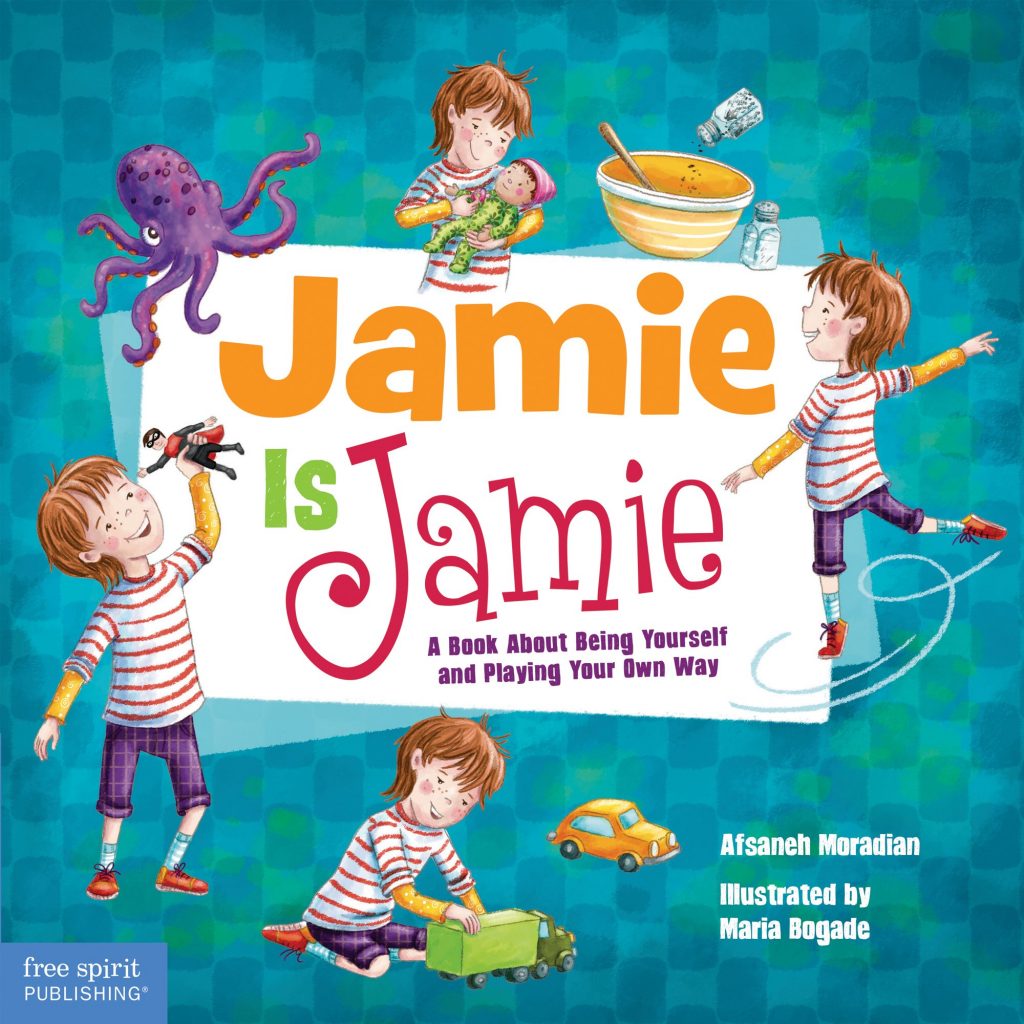
Claire-Voe and Kendra Ocampo have cried many tears together since falling in love in Boston and getting married in 2014 in New Jersey, just months after same-sex marriage became legal in the state. They’re two moms to two mighty daughters, Xiomara and Violet, who cry often (and that’s okay!) about spilled milk, a wet diaper, or going to school.
When they’re not writing, you might find Kendra and Claire-Voe eating Spanish tapas, video gaming, or watching sappy rom-coms which often brings them to tears. Kendra Ocampo and I had a conversation about our books, Mighty May Won’t Cry Today and the Jamie is Jamie series.
About Might May Won’t Cry Today

Mighty May Won’t Cry Today tells the story of May, an imaginative and determined girl who tries not to cry on her first day of school. May’s first day of school is filled with many adventures and emotions as she is faced with unexpected, embarrassing, and overwhelming moments. Young readers will relate to the experiences of May’s day—riding the bus for the first time or forgetting her favorite drink at home. At last, May will face the ultimate challenge and she cannot hold back her tears.
About Jamie is Jamie

Jamie is Jamie was originally written by Afsaneh for her daughter who’d been told that only boys can play a superhero.
When free-spirited Jamie arrives at a new preschool, all the kids learn that it’s okay to play whatever you want. The other children love how Jamie plays, but is Jamie a boy? Or a girl? Within these pages, readers see Jamie’s willingness to rock a baby, fix a toy car, dance ballet and even fight off villains has nothing to do with gender and everything to do with the joy of PLAY.
What inspired us to write Mighty May and the Jamie series?
K: Our inspiration came from our children and their love of books. We were bringing home so many books, first for our oldest, and we quickly realized there was a lack of diversity in both classic children’s books as well as the newer ones. They really portrayed the traditional family structure, so we started searching for books that had more representation for LGBTQ families in children’s literature. We wanted to be able to see our family reflected in the books we were reading, especially for our two daughters.
We began speaking to friends who also said that they wanted more diversity, that they wanted their children to be exposed to other types of families early on, too.
A: We similarly had a difficult time finding a book where my child could see herself in the story. Like many books that we read with strong female characters, my child didn’t relate to the characters as princesses or in dresses. Young children are still learning about who they are from toys, books, and media with gender stereotypes present. I wanted to write something so that children could feel free to be themselves and feel celebrated for it.
What are the key messages for children and adults in our books?
A: When I write children’s books I think about what I’d like children to get from the story, but I also think about what I am communicating to adults through the story. For example, within the pages of Jamie is Jamie, children see that play does not have a gender and that they should be free to be themselves. The adult reader is reminded not to give toys/games a gender and to let children play without restrictions or interference.
In Jamie and Bubbie (releasing in October of 2020), both children and adults learn that pronouns can change and that it’s important to know how to use the singular they.

What are you hoping children and adults take away from Mighty May?
K: The book is a reminder to really think about things from the child’s mind’s eye. We jump to a lot of conclusions just from what we were taught. The story of Mighty May is really about crying. The story is about May dealing with the emotions that she has all day and, bravely trying not to cry. Ultimately, she learns from her moms that it’s okay to cry.
Often times, something that seems small and insignificant to us adults, can be a big deal to a child and Mighty May helps adults remember how upsetting it can be to a child to stain their clothes, etc. The more adults empathize with the experience of the child, the more they can help the child deal with their emotions, rather than being dismissive and telling them to get over it.
Both Mighty May and Jamie is Jamie take place on the first day of school. How can teachers use books in the classroom?


K: May has to handle different things that happen that upset her. She tries to be brave and not cry but gets support from other children, her teacher, and her moms. Teachers can definitely use Mighty May to show students that it’s okay to cry and that the classroom is a community and that we’re here to help one another.
As part of creating community, Mighty May shows a new perspective of what a family can look like.
A: Jamie is Jamie is a book about friendship creating a culture of respect and play in the classroom. Jamie and Bubbie provide a great way for kids to talk about and share their pronouns. Both books help to create a classroom culture that is welcoming and celebratory of children who are gender-neutral, gender nonconforming, and transgender children.
To learn more about Kendra and Claire-Voe, connect with them via their website, or on Facebook and Instagram

Afsaneh has been teaching for over 15 years from preschool to graduate school, and is often invited to give teacher training workshops and speak at educational conferences. Her vast experience in working with different ages, academic levels, and cultures has given her the ability to work with anyone and help them achieve their learning goals. She is also the author of Jamie is Jamie.


Leave a Reply